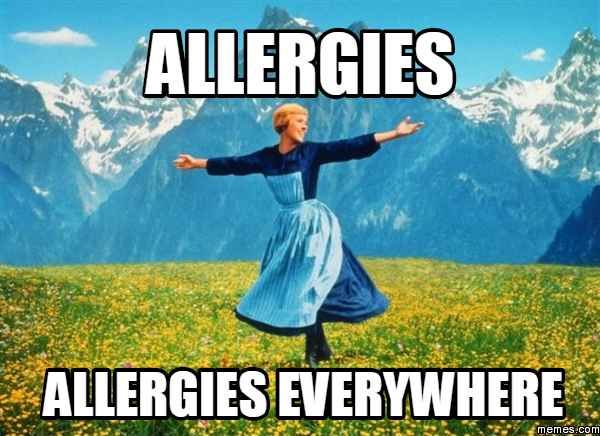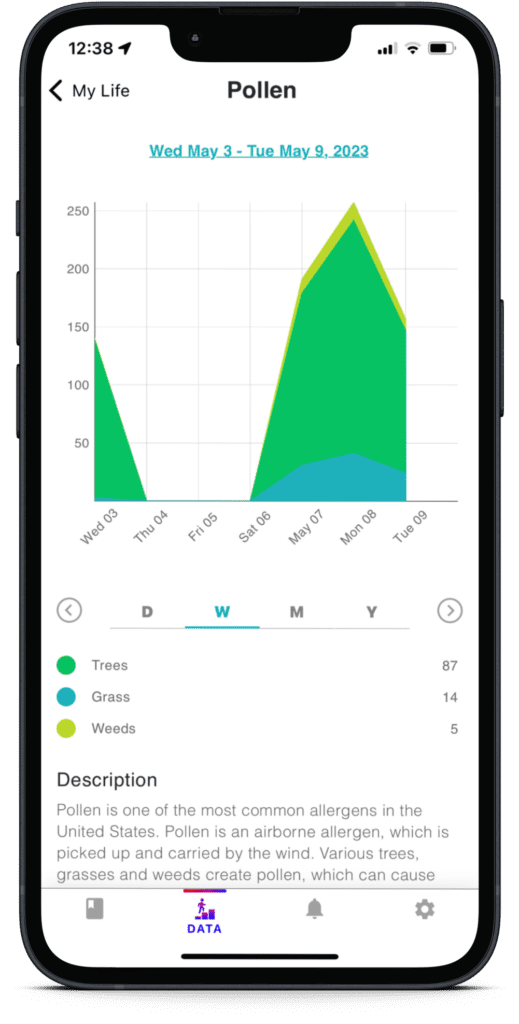Conquer Seasonal Allergies with Data-Driven Insights
Spring bursts forth with vibrant colors and blooming flowers, but for many, it also ushers in a season of misery – seasonal allergies! The sniffles, the sneezes, the itchy eyes – these unwelcome guests can disrupt your outdoor adventures. Because of these symptoms, you feel foggy and tired. That’s not the spring we all want.
The first recorded observances of the symptoms of seasonal allergies date back to Ancient Egypt and China circa 3000 BC. That’s 5000 years ago.
We’ve been battling itchy eyes and sniffles for millennia.
Usually managing seasonal allergies often involves a frustrating game of trial and error. That’s because you might cycle through allergy medications and holistic remedies, hoping to find something that offers relief. But what if there was a better way?
We will introduce you to a powerful weapon in the fight against seasonal allergies: data-driven insights. We believe in empowering you to take control of your health. With our app, you can unlock a personalized approach to allergy management fueled by the power of data and trend insights. Let’s explore how we can help you defeat seasonal allergies and finally breathe easy this spring!
The Struggle is Real: Understanding Seasonal Allergies

Have you ever wondered why your eyes suddenly itch when you step outside on a beautiful spring day? The culprit is a tiny invader: pollen. When trees, grasses, and weeds release pollen for reproduction, it floats through the air, and for some people, their immune systems see it as a threat.
This triggers the release of histamine. For that reason, it causes the all-too-familiar symptoms of seasonal allergies.
These symptoms can make even the simplest tasks feel like an uphill battle. You might experience a constant runny or stuffy nose, making breathing difficult. Your eyes might become watery and itchy, turning a relaxing afternoon into a struggle to keep them open. The constant irritation can also lead to fatigue and a general feeling of being under the weather.
In the US, 1 in 3 adults and 1 in 4 children reported having a seasonal allergy.
American College of Allergy Asthma and Immunology
While over-the-counter medications can offer some relief, managing seasonal allergies often involves a frustrating game of trial and error. You might try different medications, adjust dosages, and experiment with various remedies, all hoping to find something that works for you. But wouldn’t it be better to have a more targeted and personalized approach?
LLIF and the Best Life app: Your Ally Against Seasonal Allergies
We’ve established the frustration of traditional allergy management – the endless cycle of trying different medications and hoping for relief. But there’s a better way! Imagine having a personalized roadmap to conquering your allergies fueled by data’s power.
This is where LLIF’s mobile app, Best Life, steps in. Our app empowers you to actively manage your allergies by collecting and analyzing your health data. Here’s how:
Track Your Symptoms
Log your allergy symptoms in real-time, pinpointing the exact time, severity, and type of discomfort you experience.

Monitor Triggers
Track environmental factors like pollen count, weather conditions, and even indoor allergens like dust mites.
Analyze Trends
With LLIF, you can see the bigger picture. Identify patterns between your symptoms and environmental triggers, uncovering the root cause of your misery.
Image: Pollen count graph updates in real time within Best Life app
By harnessing the power of data, LLIF can help you move beyond trial and error. In the next section, we’ll explore how this personalized approach can lead to effective relief and a more enjoyable spring season!
Unleashing the Power of Data: Tracking for Effective Relief
Imagine this: you wake up with a stuffy nose and itchy eyes, but instead of blindly popping a pill, you clearly understand why. With that goal in mind, LLIF empowers you by turning your allergy data into actionable insights.
Visualizing the Pattern Behind Seasonal Allergies
LLIF doesn’t just store your data; it presents it in a user-friendly format. You can visualize trends in your symptoms over time through easy-to-understand charts and graphs. Simultaneously answering your most important questions alongside visualizing your data. Do your allergies tend to flare up on high pollen count days? Do certain weather conditions exacerbate your symptoms? These trends become readily apparent with LLIF’s data visualization tools.
Connecting the Dots
Now comes the critical part – identifying your triggers. You can pinpoint the culprits behind your allergy woes by analyzing the correlations between your symptom logs and environmental data like pollen count and weather. Did your runny nose appear right around the time the grass pollen count spiked? Did the sudden shift to windy conditions worsen your itchy eyes? These connections become clear once you analyze your data within LLIF.
Related: 4 Ways Technology Simplifies Seasonal Allergies
Personalized Decisions, Real Relief
With these data-driven insights, you can finally make informed decisions about your allergy management. Knowing your triggers allows you to choose the right medication for the job. For example, if dust mites are your primary trigger, antihistamines might not be as effective as a nasal steroid spray. Similarly, you can adjust your behavior based on real-time data. High pollen count forecasted? Limit your time outdoors or wear a mask to minimize exposure.
By using LLIF to track, analyze, and understand your allergy data, you can transition away from trial and error and move towards effective relief. In the next section, we’ll share real-life stories of how people have used LLIF to conquer their allergies and finally enjoy spring!
Success Stories: Conquering Seasonal Allergies with LLIF
Imagine waking up on a beautiful spring morning, ready to embrace the sunshine and fresh air – without the fear of sniffles and sneezes! This dream became a reality for many users who harnessed the power of LLIF. Here are a few inspiring stories:
Sarah’s Pollen Puzzle
Sarah used to suffer from unpredictable allergy flare-ups. Through LLIF’s data visualization tools, she discovered a clear correlation between her symptoms and high pollen counts. Now, she checks the pollen forecast in the app and takes preventive measures on high-pollen days, allowing her to enjoy the outdoors worry-free.
David’s Dust Mite Dilemma
David struggled for years to find relief from his allergies. With LLIF, he identified dust mites as the primary culprit. By tracking his symptoms alongside cleaning routines, he discovered a pattern and adjusted his cleaning habits to minimize exposure. As a result, David finally experienced significant improvement in his allergy symptoms.
Emily’s Empowered Spring
Emily used to dread spring due to her seasonal allergies. LLIF helped her pinpoint her triggers (a combination of pollen and mold) and personalize her treatment plan. With this newfound knowledge, Emily was able to effectively manage her allergies and enjoy all the joys of spring, from hiking to picnics in the park.
These are just a few examples of how LLIF has empowered people to take control of their allergies and reclaim their spring. LLIF offers a powerful and effective way to manage seasonal allergies by providing users with personalized data-driven insights.
In the next section, we’ll wrap up the blog by outlining the key takeaways and encouraging you to take action towards a happier, healthier spring with LLIF!
Questions About Seasonal Allergies
If I’m allergic to pollen and I need to go outside, what would be the best time of day to minimize the pollen’s impact on my allergies? What would ideal weather conditions look like to minimize my allergic reactions?
We get it! Sometimes, you can’t just huddle inside an airtight chamber and wait out seasonal allergies. If you’re heading outside during seasons you experience more allergy symptoms, there are a couple things you can plan ahead for.
Generally, aim for early morning to before noon to head outside. Studies have shown that pollen counts are typically lower during these times. Try to avoid heading outside during dry, windy days. If pollen is dry and the wind is strong, it gets picked up just as easily as dust and other small particulate matter. Warmer days also increase pollen release in plants, so check the highs and lows of the week to plan the best day for that outing. Rain is great for keeping pollen lower to the ground and out of your airways. Similarly, high humidity can also help keep pollen counts low.
Basically, cooler mornings after a nice rain shower or calm days with overcast are going to be better for your seasonal allergy symptom management.
How can I find out which seasonal allergens affect me the most?
Track your seasonal allergy symptoms in a journal! Luckily, we built a mobile app called Best Life that’s perfect for that. You can track your symptoms and pull up the pollen count graph later to see which pollen (tree, grass, weed) had you hit the high notes when blowing your nose.
Once you know which pollen hits you the hardest, check out the pollen forecast before heading off for your daily doings.
Finally, you can consult with an allergy specialist to run some tests and really whittle down the allergens causing you undue stress. Sometimes, you can find out more than you anticipated. For example, you could be allergic to ragweed, but those allergic to ragweed also tend to be allergic to bananas! That’s bananas!
Conclusion: Take Control of Your Spring with LLIF
Tired of Sniffles & Sneezes? We hope this blog has opened your eyes (pun intended!) to a new approach to managing seasonal allergies. Here are the key takeaways:
- Traditional methods of allergy management can involve a lot of trial and error.
- LLIF empowers you with data-driven insights to uncover your allergy triggers.
- By tracking your symptoms and environmental factors, you can identify patterns and make informed decisions about your treatment.
- LLIF’s visualization tools help you understand trends and personalize your allergy management plan.
- With LLIF, you can finally move beyond trial and error and experience effective relief this spring.
Ready to ditch the tissues and embrace a happier, healthier spring? Here’s how to take action:
- Download the Best Life app and start tracking your symptoms today.
- Explore the app’s features to learn more about data visualization tools and environmental data integration.
- See our use cases for additional resources on allergy management and how LLIF can help.
Don’t let seasonal allergies steal your spring joy! Take control of your health and breathe easy with the power of data-driven insights from LLIF and the Best Life app.
Who we are
The Live Learn Innovate Foundation is a 501(c)3 nonprofit entity that empowers software users to regain control of their personally generated health data, gain intuitive insights about their social data, learn the impact of their environment on health, and build a foundation of data analytics that empowers research, academics, and innovation in economic development.
Use cases for this secure, private data aggregation method appear everywhere, expanding to family care, community growth, agricultural planning, and many more things still unseen. Help us keep going by getting involved today.